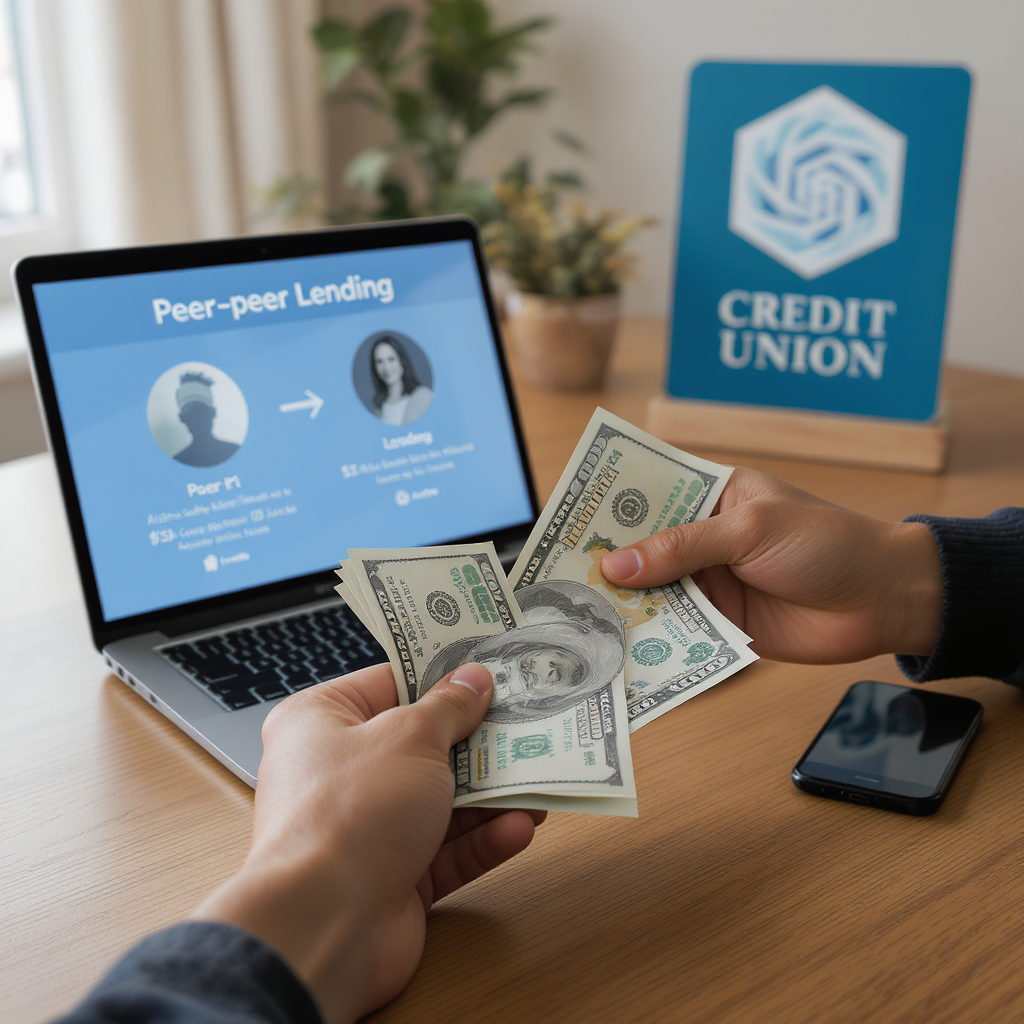Unlocking Borrowing Power – Navigating Alternative Lending When Credit is Low

Have you ever felt that your credit score is an invisible barrier, keeping you from the financial help you desperately need? I’ve been there—watching as traditional lenders close their doors, leaving me wondering if there’s any way out. It’s frustrating, isn’t it? The very system designed to help sometimes feels like it’s set up to exclude.
But recently, I stumbled upon something that changed my perspective: alternative lending options tailored for people with low credit. Imagine not being confined to the usual, often harsh lending avenues but having choices that respect your situation and offer real opportunities.
Take peer-to-peer lending platforms, for instance. I found out that these platforms connect borrowers directly with investors, often resulting in more flexible terms and better rates than traditional banks. It’s like bypassing the gatekeepers and finding support within a community willing to take a chance on you.
Then there’s the growing role of credit unions. Unlike profit-driven banks, credit unions often provide loans specifically designed for those with less-than-perfect credit. Their payday alternative loans come with capped fees and interest rates, which feels more like a helping hand than a trap. And with regulations tightening to protect borrowers, these options seem increasingly viable.
I also learned about secured loans, where offering collateral can improve your chances and loan terms. But that raised a question in my mind: is risking your asset worth it? It’s a delicate balance—between opportunity and caution—that I’m still trying to understand.
Something else caught my attention: the integration of ‘Buy Now, Pay Later’ loans into credit scoring models starting this fall. This shift means that responsible use of these services could actually help build credit history—a small beacon of hope for those starting from scratch.
So why does all this matter? Because knowing these alternatives can change the way we approach borrowing. It’s not just about getting money—it’s about regaining control and rebuilding trust with the financial system.
As we explore these options together, I invite you to think: could these alternative pathways be the beginning of your financial turnaround? What concerns or hopes do you carry about borrowing with low credit? Let’s navigate this landscape with open eyes and cautious optimism, discovering what truly works—and what might still be missing.
In the next steps, we’ll delve deeper into each option, unpacking the benefits, risks, and practical tips to empower you in your borrowing journey. Because sometimes, the first step is simply knowing there’s a way forward.
Navigating the Maze: Practical Steps Toward Alternative Lending with Low Credit
When the walls seem to close in—when traditional lenders turn you away because your credit score doesn’t meet their standards—it’s easy to feel stuck. But what if the maze isn’t as impenetrable as it seems? What if, instead of banging against a locked door, you could find a hidden passage? This is where alternative lending options come into play, offering not just hope but actionable paths. Let’s walk through some practical steps you can take to explore these alternatives.
Understanding Your Starting Point Assessing Your Financial Landscape
Before diving into options, it’s crucial to take a clear-eyed look at your current financial situation. I’ve found that this is often the most overlooked step—but also the most empowering. Ask yourself: How much can I realistically borrow and repay without stretching too thin? What are my monthly income and expenses? Do I have any existing debts? This reflection isn’t just bookkeeping; it’s about setting realistic expectations and protecting yourself from future hardship.
Step 1 Exploring Peer-to-Peer Lending Platforms
Peer-to-peer (P2P) lending has been something of a revelation. Platforms like LendingClub or Prosper connect borrowers directly with individual investors, often resulting in more flexible terms and competitive interest rates compared to traditional banks. But how do you start?
- Research the platforms: Visit each P2P site, read their borrower requirements, and understand their fee structures.
- Prepare your application: Gather necessary documents—proof of income, identification, and any credit history you have.
- Compare offers: Don’t settle for the first offer. Rates and terms can vary widely.
Keep in mind, P2P lending isn’t risk-free; your credit score still matters, but these platforms often weigh other factors, which could be an advantage.
Step 2: Engaging with Credit Unions and Payday Alternative Loans (PALs)
Credit unions are often the unsung heroes for those with low credit. Being nonprofit and member-focused, they tend to offer loans with lower interest rates and fees. Many offer PALs, which are designed as safer alternatives to traditional payday loans, with capped fees and clearer terms.
- Join a credit union: Membership might require living in a certain area, working in a particular industry, or having a family member who already belongs.
- Inquire about PALs: Ask about loan amounts, repayment terms, and any eligibility requirements.
- Understand the regulations: PALs are regulated to protect borrowers, but terms vary, so read the fine print carefully.
This approach not only offers better terms but can also be a stepping stone to rebuilding credit.
Step 3: Considering Secured Loans—Weighing Risks and Rewards
Secured loans might seem like a double-edged sword. Putting up collateral—like a car or savings account—can open doors to better rates and approval chances, but it also means risking what you’re offering if repayments falter.
- Evaluate your assets: What can you realistically use as collateral without jeopardizing your financial security?
- Calculate repayment ability: Be brutally honest about your ability to meet monthly payments.
- Shop around: Different lenders have different terms for secured loans; compare carefully.
The key is balancing opportunity with caution. Is the potential benefit worth the risk? Only you can decide.
Step 4 Leveraging Emerging Trends—BNPL and Credit Building
A fascinating development is the inclusion of Buy Now, Pay Later (BNPL) loans in credit scoring models starting this fall. If you’ve used BNPL services responsibly, this could help build your credit profile.
- Use BNPL thoughtfully: Make payments on time to positively impact your credit score.
- Monitor your credit: Use free tools to track how BNPL affects your score.
- Combine with other efforts: Pair BNPL usage with other responsible borrowing to build a stronger credit history.
This trend reflects a shift in how lenders view creditworthiness—more nuanced and inclusive.
Tips and Precautions Along the Way
- Always read the fine print: Whether it’s P2P platforms, credit unions, or secured loans, understanding the terms is vital.
- Beware of scams: The less traditional the lending option, the more vigilant you need to be.
- Stay realistic: Don’t borrow more than you can repay, no matter how tempting.
- Keep learning: Lending landscapes evolve—stay informed about new regulations and options.
What Might Be Missing?
Even with these alternatives, a question lingers: are these options enough to truly level the playing field for low-credit borrowers? The system is shifting, yes, but systemic barriers remain. Is the path forward more about individual navigation or collective change? I wonder if, alongside these practical steps, there’s room for broader innovation and advocacy.
For now, though, recognizing and utilizing these alternative lending routes is a powerful first step. What do you think? Are these avenues something you feel ready to explore, or do they raise new questions or concerns? Let’s keep this conversation going—because every step, however tentative, is a move toward reclaiming financial agency.
In the next phase, we’ll dive into detailed case studies and step-by-step guides tailored to each lending option, so you can try these methods directly and confidently. Because sometimes, the best way forward is simply to begin.

Reflecting on the journey through alternative lending options for those with low credit, it’s clear that these pathways represent more than just financial tools—they offer a chance to regain control and reshape one’s relationship with money. From peer-to-peer platforms fostering community trust, to credit unions providing safer, more compassionate loans, and even emerging trends like Buy Now, Pay Later influencing credit building, each step carries its own promise and caveats. This mosaic of options suggests a gradual shift in how financial inclusion might be approached—not as a one-size-fits-all but as a nuanced, evolving process.
What stands out is the empowerment found in understanding and navigating these alternatives thoughtfully. Recognizing your financial landscape honestly, exploring options with curiosity yet caution, and embracing new credit-building trends are all practical moves that can initiate real change. These strategies don’t just offer credit—they invite a rebuilding of trust, both in the system and within ourselves.
So, what can you do now? Start small: assess your current financial standing with honesty; research one peer-to-peer lending platform or credit union near you; consider the risks and benefits of secured loans carefully; and watch how your responsible use of BNPL services might enhance your credit profile. Each action is a step forward, a concrete way to move from feeling excluded to becoming an active participant in your financial future.
Looking ahead, it’s intriguing to imagine how these alternative lending avenues might evolve, perhaps blending with technology and policy reforms to create even more inclusive opportunities. Yet, the question lingers—will these developments be enough to overcome systemic barriers, or is there a larger conversation and collective action still to be had?
I invite you to carry this question with you as you take your next steps. What possibilities do you see emerging from these alternatives? And how might your personal experience add to the broader story of financial inclusion? The path isn’t perfectly clear, but by engaging with these options and reflecting on their impact, we are part of shaping what comes next. If this exploration resonated with you, why not try applying one of these approaches today? After all, sometimes the most important progress begins simply by taking that first, informed step.





